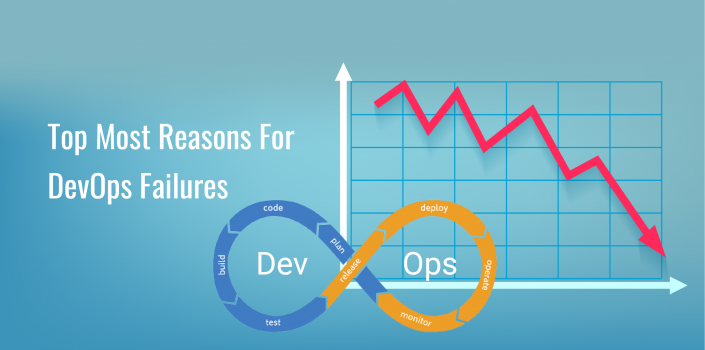"The Future Of The Cross-Platform Is Native: Why?"
"Advantages Of The Laravel Framework For Developing MVC Based Web Applications"

This research will help leaders recognize the most common causes of DevOps failures. We have gathered thoughts of some experts about these failures and their reasons. The explanations are all explicit and actionable. Forewarned is forearmed!
Here Are Some Of The Top Reasons For DevOps Failures
Any process change is either rejected or embraced by those undergoing it. When DevOps fails, it’s easy to point fingers, without really getting to the root of the cause.
1. “DevOps department” creation:
Perhaps the easiest way to avoid in the organization but also the most common is when DevOps adopters create a new department to manage the framework and strategy. “Sometimes, organizations add a new department without removing/shuffling something (or someone), so it ends up adding red tape and more processes,” says Rod Cope. When the organisation is starting a new process or idea, they need to focus on how it will affect the other connected parts and not just jump straight into the new idea. Organizations need to focus on the new processes of DevOps instead of introducing a new department.
2. Properly consider all other resources and staff workloads:
Before dumping a DevOps strategy on the workers, a clear understanding of their team’s capabilities and workloads of the employees needs to be taken into consideration. Quantify the workload and the workload of each individual’s performance. If needed, hire new resources or re-prioritize the workload. DevOps department is a terrible idea, but at the same time, implementation isn’t going to manage itself. Someone has to manage resources talent and budget, and tasks must still be delegated appropriately. “Failure comes out of an inability to prioritize and break down issues,” says Brodie.
3. Unrealistic goals Setting:
Transformation is directly proportional to the strength of the enterprise. The larger an enterprise, the longer the transformation. It’s important to track and set multiple metrics that are aligned and are specific to the goals. However, customer satisfaction, quality of service, or overall revenue goals do have relevance to the business and should be tracked vigorously.
4. Attempt to create a “hybrid” DevOps, while keeping old structures intact:
Bringing DevOps into a well-established organization can cause culture shock and some pushback from the file and rank. Development often works towards answering tickets quickly and bringing out new features ASAP and has historically been at odds with operations, which functions to ensure utopian uptime to pledge that systems function appropriately. This culture generally takes time to transform.
Some organizations in a misguided attempt try to keep the old culture intact, build a hybrid structure that applies agile methodologies but keeps IT operations and engineering/development teams in their traditional silos. This is especially problematic if Dev and Ops teams are in different offices geographically. These groups need to be combined through a significant investment in improved communication or physically to create a collaborative environment that DevOps requires. Anything else will result in a “half-baked” DevOps implementation that will not meet the organization’s goals and is doomed to failure.